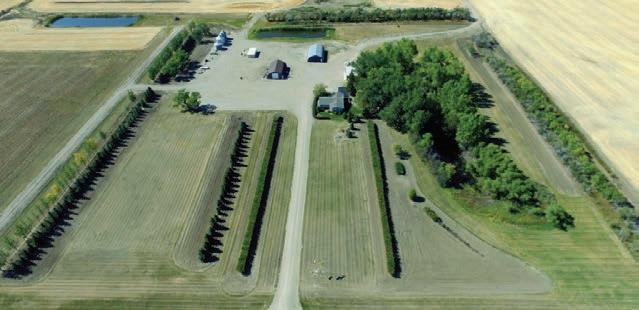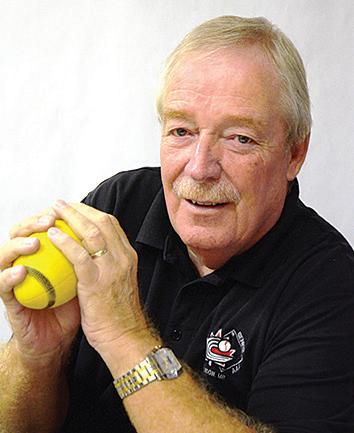





Legislative Assembly of Saskatchewan
Ken Francis, MLA Kindersley Constituency
kfrancismla@gmail.com












Legislative Assembly of Saskatchewan
Ken Francis, MLA Kindersley Constituency
kfrancismla@gmail.com






JOAN JANZEN joanjanzen@yahoo.com
While farmers are busy seeding and gardeners are planting, another local enterprise has its work crew assembled and working. Janeil Enterprises and Sweetheart Pollinators, located seven km southwest of Eatonia, are gearing up for their upcoming honey and pollination season.

Janine and Neil Specht started bees as a passionate sideline to their struggling grain farm back in the ’80s when interest rates skyrocketed to 16 percent. The Specht’s lost the farm but were fortunate to have a hobby that became a thriving bee operation.
When asked if running a bee operation was a bit of a learning curve, Neil’s laugh
said it all. “It was a huge learning curve,” Neil said. “Bees are like that; when you think you know it all, the bees will teach you one more lesson. Keeping them alive is a lesson. We’ve had losses in the 70 percent range. We have had a couple of times of 40 percent losses. In beekeeping, you do that more than two years, and you’re done.” CONTINUED NEXT PAGE

CONTINUED FROM FRONT
But Neil kept on learning, taking a course by Simon Fraser. “Everyone in the industry is ready to share, and you learn from them,” he noted. “We became big enough that I was part of the Western Canadian co-operative Bee Maid. I took a board of directors job with them.” Bee Maid Honey is owned by over 300 Canadian beekeepers located in BC, Alberta, Saskatchewan and Manitoba. If you check
out Bee Maid honey, you may see photos of Janine, Neil and their daughter Megan pictured on their containers.
Neil’s daughter Megan looks after their queen breeding program. She has her own bees and continues to train new staff in this delicate process which takes gentle hands and very good eyes. It begins with queen cells in June, which soon become queen bees ready for their new colony. The queen bee is busiest in
the summer months and can lay up to 2500 eggs per day.
“We make our own queens, but we also purchase about 1200 queens,” Neil explained, adding that they need queens sooner than they can breed their own because it’s too cold here. They breed the queens for the desired genetics and choose a gentle colony. No disease means the queen is good.
“The queens come into Calgary, and I fly with

my plane, pick them up and bring them home,” Neil said. “That’s how we make up for losses during the winter; winter is hard for them. We produce under 1000 of our own queens. The ones we purchase come out of Hawaii. Others come out from Canada later in the season. Queens last multiple years. We generally try to change them seasonally.” The queens cost about 42 dollars apiece and require a multitude of insects to survive.
This year the Specht’s will be running 5000 colonies, but it’s Sweetheart Pollinators that allows their enterprise to thrive. “We went into pollination to have a business that we can thrive on,” Janine said. “Because of where we are located, honey is a bi-product.”
Neil said that because they were offered pollination contracts that were guaranteed for three years, they could grow by 1000 colonies per year. “We pollinate hybrid canola. It can’t produce male and female flowers, so we pollinate for them,” Janine said. Pollination begins at the end of June, primarily in the Medicine Hat and Bow Island area. “Their seed is certified canola, so it has to have isolation, so it doesn’t cross-pollinate,” Janine continued.
The work crew moves the beehives by truck to fields that need pollinators. Bee moves happen at night because bees can’t see in the dark and aren’t flying around. There are many beehives in pollination fields, so there is a lot of work involved to make sure they have room for honey from the canola. The work crew checks the hives to determine if they need one or two supers (empty boxes filled with honey). The supers are placed on top of the hives. If the bees aren’t given an extra box to fill with honey on time, they can form a swarm on a fence post or other object.
certain chemicals, which allows farmers to spray the field,” Neil explained.
The work crew at Janeil Enterprises is also valuable. “We have twenty employees, including three new guys this year and four students. There are several Mexicans, Ukrainians, two South Africans, one Filipino and some Canadians,” Neil said. “We are the United Nations of employees of Eatonia.”
Most of the employees return for multiple years.
“Seasonal workers are hard to find, and it’s hard work. So they come on their off-season,” Janine said. “We spend all year training, and every day is a different job. The next year they are trained, so you need returning employees.” Janine and Neil found it beneficial to provide accommodation for their employees.
One of those valuable employees is Kostiantyn Tyschchenko, who is originally from Ukraine. Kostiantyn is the Manager at Janeil Enterprises and keeps everything operating smoothly. After a long winter, the protective wrapping and insulation are removed from the hives. Bees are placed in about 200 bee yards, from Oyen, to Consort, Fiske and Bow Island, and the crew checks on them every ten days. Over 12,000 boxes go out
into the fields.
“We package about 10,000 pounds of honey a year,” Neil said. “We don’t pay people for having the bees in their yards, so we give quite a bit of honey away and put some in stores in Kindersley, Leader, Eatonia and Oyen, for those people who are asking for local honey. We send ten or twelve semi loads of honey to Bee Maid in Edmonton every year.”
“We now have 5000 colonies of honey bees, mostly for pollination. We produce about 700 barrels of honey (each barrel holds 650 pounds) and two tons of wax annually. We can extract about ten barrels of honey a day when things keep running,” Neil said.
While honey is a bi-product of the pollination work done by Sweetheart Pollinators, wax is a bi-product of making honey. In the process of making honey, the bees make wax which is part of their comb. Bees create wax in a special wax gland on their stomach. The worker bees then chew these flakes of wax to become soft and mouldable, which they then form into honeycomb. Honeycomb cells store not only honey, but nectar, pollen, water and are used as a nursery for larvae.
CONTINUED PAGE 3
Saskatchewan Party MLA for Cypress Hills
In April, most provinces saw their job numbers decline and unemployment go up. In Saskatchewan, employment was up by 9,500 new jobs – the strongest job growth in all of Canada. Unemployment fell to 6.6 per cent – the lowest in Canada.
New job numbers show more women, more men, and more young people working. There were more construction jobs, more tech jobs, more jobs in agriculture, in manufacturing, health care and education. In fact, there were more jobs in almost every area.
Investing in infrastructure during a pandemic provides a unique opportunity to create jobs and improve quality of life. For example, our government continues moving forward on approved projects under the Municipal Economic Enhancement Program (MEEP).
42’ steel shop 2 overhead doors, heated
2 dugouts on the property and access to a 3rd dugout. Yard has underground sprinklers and drip system. Miscellaneous yard equipment is negotiable with the sellers. CONTACT: BRAD EDGERTON@ 306-463-7357
“The bees stay in the canola fields for three weeks to a month until agronomists tell you when they need to be removed. There are thousands of bees in a small area, so when crops stop flowering, there’s nothing for the bees, and they need to be removed,” Janine said.
“The seed is so valuable that they can afford to pay us to bring the bees. The seed is sold by the pound, not by the bushel, and is resistant to


A total of 760 Saskatchewan municipalities have now received funds through MEEP, which is a key component of our two-year, $7.5 billion capital plan to build a strong province and stimulate our economic recovery. To learn more or to see a complete list of approved projects, visit www. saskatchewan.ca/municipal-economic-enhancement.















2
You will see a small white jelly beanlike spot in each cell in a honeycomb, which are bee eggs. Bees have four life stages: egg, larvae, pupae and adult. The eggs will hatch in about 3-4 days as larvae. From there, larvae will grow quickly and, in about six days, will turn into a pupae. After twelve additional days, the pupae will emerge from the cell as a fully grown bee.
Dandelions are one of the first sources of nectar and pollen for honeybees, and honey can look and taste quite different depending on different floral sources. The crew begins bringing honey home from the pollination fields sometime in July. A leaf blower type of backpack gently blows the bees out
of the boxes with frames full of honey; then the crew adds more boxes with empty frames. The frames full of honey are stored at room temperature overnight before the honey is removed. First, the wax is removed from the frame. “It takes seven pounds of honey to make one pound of wax, so wax is fairly valuable,” Janine explained. “Wax is used for beauty products.” The wax is sold by the truckload to large bulk buyers like makeup manufacturers.
Honey season wraps up in late September when the staff returns to school or to their home countries. But they’ll be back again in 2022, ready to begin the process of making honey and pollinating crops.






JOAN JANZEN joanjanzen@yahoo.com
How much wood would a woodchuck chuck if a woodchuck could afford to chuck wood? If the woodchuck needed to purchase wood at today’s prices, he would likely have completely stopped chucking wood in 2021.
In a similar fashion, most home owners are postponing any renovation projects until lumber prices go down, which some say may not happen until at least the fall. Contractors and home renovators are wanting to know when prices will drop, why prices increased so dra-
matically, and who is profiting from those high prices?
“It’s a perfect storm of very strong demand and a very slow supply response because of a decade of under-building and Covid-19,” said Paul Janine of Forest Economic Advisor. He noted many sawmills reduced production expecting demand to plunge, but instead were hit with a wave of renovation projects. Low interest rates combined with people moving to rural homes caused a substantial increase in home construction. Consequently saw mills and dealers were unable to replenish their inventories.

wise contractors stocked up on lumber before the price increased.
In the U.S., The National Association of Home Builders suggested the administration

Premier Scott Moe said some things last week that were very different in his bluntness.
He spoke to those who aren’t yet vaccinated — especially those who are refusing to get a COVID-19 vaccine and are encouraging others not to get it.
And unlike previous occasions when either he or Health Minister Paul Merriman politely suggested getting vaccinated was a matter of personal choice, the Premier didn’t mince many words.
“We’re not asking you to storm the beaches at Normandy,” Moe said.
“All we’re asking you to do is go in and get a tiny needle in your arm.”
Other premiers like Ontario’s Doug Ford and Manitoba’s Brian Pallister have been more blunt. Moe has been more guarded … until now.
Admittedly, it was a tad puzzling in the context of the overall message that Moe and Saskatchewan Chief Medical Health Officer Dr. Saqib Shahab.
Both again said vaccinations in this province have been a huge success story.
We are at or in the lead among the provinces (the territories are way ahead of the provinces in general) in the percentage of our population vaccinated.
And at at his most recent briefing, Moe re-emphasized Saskatchewan’s vaccine success that has seen 80-percent-or-more vaccination rates among the 60 years and old age groups and pointed to large weekly percentage increases in younger age categories that have more recently been made eligible for vaccinations.
In fact, Moe said he isn’t especially worried about vaccine hesitancy in specific age groups.
His Saskatchewan Party government’s strategy of doling out vaccinations mostly through an age-based system — as opposed to d to seeking out younger, frontline workers for vaccinations earlier — has drawn criticism.

reduce tariffs on imports from Canada, which is their top lumber exporter. The volume of imports from Canada, which supplies almost a third of the U.S. lumber supply, decreased due to those tariffs and a mountain pine beetle that devastated forests in B.C. A wood shortage caused by the mountain pine beetle and wildfire damage resulted in the closure of a mill at 100 Mile House.
A video blog by Tony’s Tractor Adventure addressed the subject of rising lumber prices. As an amateur sawyer and logger, he knows first hand that it takes a lot of work to turn logs into lumber. He receives repeated comments from truck drivers, factory workers in saw mills and sawyers who say they aren’t making any more money. The people who own and sell the logs say they are bringing in the same amount of money as they did twenty years ago. According to the Wall Street Journal, timber growers have gained nothing from the rising prices of lumber. When you take into consideration inflation, logs are selling for less now than in the 1980’s.
Sawmills were able to keep up with the demand that was needed, until the shut down when box stores were permitted to stay open as an essential service. Shut up at home, the
It would seem rather obvious that the Saskatchewan Health Authority (SHA) drive-thrus are better suited for people with access to vehicles and who have the ability to take time off work to get to those clinics. The success of those drive-thru clinics in Regina and Saskatoon has been somewhat driven by people driving in for hundreds of miles from throughout rural Saskatchewan and willingly waiting in line.
This was very good thing and has clearly contributed to Saskatchewan’s high vaccination rate.
entire population began renovating, wiping out the supply chain of lumber.
The sellers buy the product for a price and raise it up a margin. That margin is pretty well stabilized throughout all the box stores. Meanwhile, the large saw mills and wood product manufacturers are in control of a huge portion of the lumber supply chain.
The five major companies are Georgia-Pacific, Sierra Pacific Industries, Interfor, Weyerhaeuser and West Fraser. West Fraser bought mills across the regions of the U.S., and that company is now valued at $13 billion and its share price has jumped 250 per cent in the past year. According to the Wall Street Journal, Canadian firms that have bought up sawmills are harvesting profits.
In a news release, Weyerhaeuser reported a $681 million profit in their first quarter, which is a 220 percent increase over last year at the same time. West Fraser had an 81 percent sales increase over last year, bringing in a $9 million profit In the first quarter of 2020, compared to a $665 million profit in the first quarter of 2021.
Rising lumber prices are proving to be very profitable for big forestry companies. But will consumers continue buying lumber at such exorbitant prices?
ans and others like some in the First Nations communities (although there have been massively successful vaccination campaigns run by reserves as well) need special attention.
Moe mostly seemed to be addressing those isolated, individual resisters. Cumulatively, they might be adding up to a big problem for all of us in the COVID-19 fight.
“You should know and you should be fully aware of the risks,” Moe said. “Covid is not gone. You will continue to be at risk.”
Again, this seems to contrast with the government’s overall message. But, sometimes in government there, are much bigger problems than a little messaging inconsistency.
But when it’s come to getting as many people vaccinated as quickly as possible, it is a system that has also been effective.
However, judging by Moe’s concerns, there are new found worries out there about people’s unwillingness — or inability — to get vaccinations.
It also somewhat dispels an “urban myth” that vaccine hesitancy is just a rural problem driven by independent, anti-government rural types. (As one rural resident put it to me: “Those that think that way have never lived in a smaller community where everyone knows everyone else and aren’t shy about saying something.”
That said, Moe’s remarks last week did also acknowledged newer Canadi-
Moe clearly sees resisters as the big problem and appealed to them directly to help end the restrictions he also hates.
“I hate it,” the Premier said, of those imposing his restrictions. “I look forward to the day it all ends.
“But that day can only come when enough of us choose to be vaccinated.”
And right now, Moe’s foremost concerned is those who won’t be vaccinated.
JOAN JANZEN joanjanzen@yahoo.com
The online Facebook auction hosted by the Leader Lions Club has had excellent results. Lions member Dustin Heatcoat reported on the fundraiser’s outcome. “We’re right around $67,000, but there are still people donating, which is fantastic!” People are still paying for their purchases, and some are topping up the amounts, which Dustin said is “pretty awesome.”
“We knew it would be well received by the community, but we were absolutely blown away! People were creative with their donations,” Dustin said. A total of 257 auction items were donated by people who live in the surround-
$67,000!
ing area or are tied to the community in some way.
“The funds generated won’t cover all the capital expenditures, but it will put a big dent in what needs to be done,” Dustin explained.
Recreation Director, Rochelle Francis, was invaluable to the success of the fundraiser. “Ultimately, all the donations had to go through her, and a big shout out to everyone who works at the town office for fielding calls during the whole three weeks. It put a lot of extra work on their plate,” Dustin added.
In addition, the fundraiser generated an awesome response from businesses in Swift Current and Kindersley that stepped up and helped out.
Great Plains College is pleased to announce the addition of an Educational Assistant (EA) program to its Kindersley Campus offerings. The part-time certificate program is set to begin in January 2022.
“After talking with community partners and completing a program needs assessment in the Kindersley region, the need for a local Educational Assistant program was evident and we’re pleased to be able to meet that demand in our community,” explained Fritz Eckstein, region manager at Great Plains College. “Educational assistants provide immeasurable support to students and teachers in our education system and
Kindersley RCMP were kept busy over the holiday long weekend. On top of several check stops and extra traffic enforcement to round out Canada Road Safety Week the local Detachment responded to a further 59 calls for service.
On May 22nd RCMP responded, with Fire and EMS, to a serious injury accident near Smiley that resulted in STARS air ambulance being dispatched. One person was
transported by air with non-life threatening injuries. The collision remains under investigation.
In addition to this collision investigation other calls for service included, eight suspicious person/ vehicle calls, two Firearms Act calls, one break and enter and five 911 calls.
If you need to report any suspicious activity in your community, please contact the Kindersley RCMP detachment by calling
306-463-4642 or their local police service. Information can also be provided anonymously through Saskatchewan Crime Stoppers by calling 1800-222-TIPS (8477) or submitting a tip online at www. saskcrimestoppers.com.
Online Crime Reporting can be accessed at: https://ocre-sielc.rcmp-grc.gc.ca/saskatchewan.
*For more information on the calls to service please contact the Kindersley RCMP detachment.
we look forward to helping many individuals get started in this career path.”
The program will cover everything from basic care skills and crisis prevention techniques, to social, emotional and cognitive development through a combination of in-class learning and two practicums.
them be better prepared for the workplace after graduation.”
Those interested in the program can apply to the full part-time program or enrol in individual courses that will be scheduled throughout 2022-23.
“Practicums are an important part of the program structure,” added Eckstein. “Students are required to complete a practicum in both an elementary and high school setting, which will give them the opportunity to practice their skills and gain experience with real students in different classrooms, helping
A completed EA program may also give credit for Level 1 in the Early Childhood Education program (pending Ministry approval) and up to six credits toward the Disability Support Worker program.
David J. Anderson D.D. & Caitlin Geiger D.D. 109 - 1st Ave. West, Kindersley, SK 1-306-463-4124
Call today for an appointment. •
For more information about the EA program, to view the course list or to apply, please visit greatplainscollege.ca/ea.

David

The Kindersley and District Music Festival committee was happy to be able to hold the second part of our annual Festival from April 26-27, 2021 at the Kindersley Alliance Church. Though there were some last minute accommodations that needed to be made due to changes in Covid restrictions, our committee was very pleased to be able to host a live performance and adjudication Festival.
Beginning on Monday morning, several talented string, woodwind and brass musicians took to the stage, while Tuesday brought many skilled percussionists, performing for the volunteers and staff who were there to help make things run smoothly. The adjudicator, Gene Aulinger, a former band teacher in Kindersley, remarked several times on the superior caliber of our young musicians.
Following is the list of our scholarship awards and their winners for the 2021 Strings, Brass, Woodwind and Percussion classes. As always, we were delighted to have so much local sponsorship for our adjudicator to award to our students.
STRINGS, BRASS & WOODWINDS
Kindersley & District Arts Council (Strings) - $50.00 - Trinity Long Knights of Columbus - $25.00 - Kailey Herner
Westcliffe Band Parents’ Association - $50.00 - Tia Townsend
Westcliffe Band Parents’ Association - $50.00 - Evan Pelletier
Beryl Near Jr Award (Intermediate Brass) - $50.00 - Addisyn Connolly
Longhorn Oil & Gas - $50.00 - Rachel Krogstad
Royal Canadian Legion - $50.00 - Evan Pelletier
Kindersley & District Arts Council - $50.00 - Chelsea Martin
Holland’s Hot Oiling - $50.00 - Tia Townsend
Holland’s Hot Oiling - $50.00 - Rachel Krogstad
St Joseph Catholic Women’s League - $50.00 - Kaitlyn Herner
Dancin Oilfild Services - $50.00 - Gracie Rawson
KCS Band Parents’ Association - $75.00 - Angela Bosch
KCS Band Parents’ Association (A Promising Woodwind) - $75.00 - Kailey Herner
Isabel Appleby Memorial (Promising Flute performance) - $100.00 - Rachel Krogstad
Precision Instrumentation - $100.00 - Trinity Long
Eatonia Band Association - $100.00 - Dylan Ahrens
TD Canada Trust - $100.00 - Evan Pelletier
Kindersley Masonic Lodge Award (Excellent Sr) - $200.00 - Chelsea Martin
PERCUSSION
Rotary Club of Kindersley (Promising Mallet Solo) - $25.00 - Moira Padberg
Rotary Club of Kindersley (Promising Multiple Percussion) - $25.00 - Maggie Schwartz
Donald H Barclay Memorial Percussion Award (Under 12) - $50.00 - Carter Torry
Westcliffe Band Parents’ Association - $50.00 - Sam Coles

KCS Band Parents’ Association - $75.00 - Moira Padberg
Jim Gardner Memorial Award - $100.00 - Maggie Schwartz
We are also very proud to be able to send 3 individuals to the Provincial Music Festival competition.
Chelsea Martin - Intermediate Woodwind
Evan Pelletier - Intermediate Brass
Rachel Krogstad - Intermediate Woodwind
Again, the Festival committee wishes to thank and congratulate all our participants and their teachers and families for all their hard work through the year in order to compete at such a high level. We applaud all our winners, and wish those moving on to Provincials all the best. The quality of music our small community produces year after year has been commented on by all of our adjudicators, and we are very proud!




Whatdo the following people — Joe Musgrove, Spencer Turnbull, John Means, Carlos Rodon, Corey Kluber and Wade Miley — have in common?
Unless you’re an avid fan of Major League Baseball, you might not know the answer is that the aforementioned sextet had pitched no-hitters in the first seven weeks of the 2021 season. The number would be seven if Madison Bumgarner’s seven-inning no-hitter was counted, but MLB has said no-hitters won’t be recognized if they happen in shortened games in doubleheaders.
Considering, for example, there were only two no-hitters thrown in all of 2018 and only one each in 2017 and 2016, having six occur in the first seven weeks of 2021 is rather remarkable. But it begs the question: What the heck is going on?
Easy. Pitchers are getting better, and hitters aren’t.
The overall MLB batting average through May 23 was an abysmal .235. Used to be that it was an insult to call somebody a .250 hitter, but these days, that number would be well above average.
In 1968, the overall MLB batting average was .236,
with Carl Yastrzemski’s .301 good enough for the American League batting title. As a team, New York Yankees hit .214. Baseball took action, lowering the mound to minimize the dominance of pitchers, and tightening the strike zone. This isn’t 1968, but MLB may decide to do something drastic once again to get more hitting, more offence, more excitement, into the game.
Fans are staying away — and not just because of COVID-19 restrictions — because games are dragging, not to mention the excitement level.
Home runs are up; doubles and triples are down. Teams rarely bunt anymore. Pitched balls are put into play less frequently. Strikeouts are up, again. A record number of strikeouts has been set every year since 2007. Pitchers who threw 95 miles per hour 20 years ago were freaks. Now every team has a couple of them, with most teams rostering a pitcher or two who regularly zoom past 100 on the radar gun. Said Marlins’ manager Don Mattingly: “Sometimes it’s unwatchable.”
No-hitters are fun to watch, but an 11-8 game featuring 27 hits, stolen bases, wild overthrows and spectacular catch-

es in my mind provides much more entertainment. Baseball has to figure out a way to reduce the former and increase the latter.
• Scott Ostler of the San Francisco Chronicle, describing a night at the ballpark interviewing ‘cardboard’ fans: “At the A’s ballpark, I interviewed one of those cardboard fans, the only one that was not smiling. Said the fan, ‘I wasn’t cut out for this.’”
• Comedy writer Alex Kaseberg: “MLB has had six no-hitters already. Normally they only have two no-hitters a year and sometimes none. Who would have guessed a symptom of COVID-19 would be batters hitting like one of the Kardashian sisters?”

Christina Glowa from Delisle has played an intricate role within Delisle Minor Hockey Association (DMHA), beginning in 2008 when she joined as Treasurer. Christina spends hours meticulously balancing books, providing membership with financial reports, collecting fees, paying bills, and so much more. In addition to DMHA Treasurer, Christina is also manager of her kids’ minor hockey teams. In addition to volunteering on the board and minor hockey teams, Christina also sits on the Delisle Bruins Celebration of Hockey Committee, which organizes an annual fundraising event in partnership with the Delisle Senior Hockey Team DMHA. For her continuous commitment to volunteering with the DMHA, Christina is
a deserving recipient of the Volunteer of the Year Award – North. Christina is the daughter of Marion Thompson and granddaughter of the late Fritz and Alice Peyton of the Hoosier district.
The Saskatchewan Hockey Association (SHA) was established in 1912 and is the governing body for organized hockey in the Province of Saskatchewan. With a mission to Lead, Develop and Promote Positive Hockey Experiences, the SHA encourages competition at all levels – from recreational to high performance. SHA has grown through the years and is Saskatchewan’s most prominent sports organization, with over 43,000 members comprised of players, coaches, and officials.
• RJ Currie of sportsdeke. com: “Police in Ireland broke up a fight at a chess tournament after a player was found strategizing using a computer in the toilet. Imagine that: Plotting against kings and queens on the throne.”
• Eammon Lynch of GolfWeek, on the proposed Super Golf League: “Imagine Gretzky having quit because Dancing on Ice offered more money. Or Jordan’s Bulls deciding that joining the Harlem Globetrotters was better than winning championships.”
• Comedy writer Eric Stangel, on Twitter: “While you were sleeping, nine more no-hitters were thrown.”
• Sports figure Kyle Porter of CBS, on Twitter, describing Rickie Fowler’s outfit during Day 1 of the PGA: “Rickie looks like he’s in disguise as an undercover investigator into a complex Phil Mickelson cryptocurrency enterprise.”
• Patti Dawn Swansson, on Twitter: “It isn’t easy being green, but my favourite curler, Chelsea Carey, plans to see if the colour fits. Chelsea will be skipping a team from the Flattest of Lands next season, which means she’ll be going after a rare trifecta — champion
of Manitoba, Alberta and Saskatchewan.”
• Dwight Perry of the Seattle Times: “So, which NBA team will be the first to hoist a ‘2021 Play-In Champion’ banner next season?”
• Patti Dawn Swansson again: “It’s official: The people at Guinness World Records have declared film of Corey Perry’s knee hitting John Tavares’ head to be the most dissected piece of video evidence since Abraham Zapruder’s home movie of the JFK assassination.”
• Headline at fark.com: “Leafs captain Tavares removed from ice on stretcher. Expected to recover in time to make Leafs’ tee time next week.”
• Another fark.com offering: “Shohei Ohtani is the most exciting player in MLB and will only see a World Series from the stands because he is on the Angels.”
• Steve Simmons of Sunmedia, on double threat Shohei Ohtani of baseball’s Los Angeles Angels: “In simpler Toronto terms, he is Vladimir Guerrero Jr. and Hyun-jin Ryu all in one person.”
Care to comment? Email brucepenton2003@yahoo.ca

I intend to retire from the active practice of law on June 30th, this year, and consequently I will not be able or available to take on any new clients or new work from the date of publication of this notice. Although Ard Law O ce will be closed for appointments as of June 30th, o ce sta will still be present, as we will be completing open and ongoing les.
A er June 30th the o ce can still be contacted by telephone at (306) 4632627 and by e-mail at ard.law@sasktel.net. Please contact the o ce to arrange pick up for company minute books and seals and original Powers of Attorney or Wills or other documents that may be required. Following June 30th please call or e-mail to arrange time for the pick-up.
All existing les and documents will continue to be stored securely, pending any alternate arrangements.
ROBERT ARD

The Agricultural Producers Association of Saskatchewan (APAS) welcomes the proposed changes by the Canadian Grain Commission (CGC) to reduce fees for grain inspection and weighing services saving producers almost $14 million in 2021-22 and then up to $20 million in later years.
“We have been calling for more transparency in the system, and are happy the Commission has responded to those requests,” said APAS President Todd Lewis. “This is good news for Saskatchewan producers and all producers across Canada.”
The proposed changes could come into effect on August 1, 2021. The CGC says the fee reductions are in response to growth in grain exports and will align fee revenues with fixed service delivery costs.
Proposed fee reductions:
• Reducing the cost of inspection and weighing service fees from $1.48 to $1.05 per tonne for ships.
• Reducing costs to $37.88 per official inspec-
tion and weighing services for a railway car, truck, or container.
The government estimates reducing these fees will decrease costs in the 2021-22 fiscal year by approximately $13.79 million (19%). It also estimates the cost savings will increase to approximately $20.68 million (29%) in the 2023-24 fiscal years.
“These savings will allow producers to invest more in their operations, and we thank Minister Bibeau for reducing fees on this essential service for our producers,” Lewis said. “This fee reduction is the result of good work by Chief Commissioner Chorney and the staff at the CGC.
Public comment on the proposed changes will occur on May 22 in the Canada Gazette, and stakeholders can submit their feedback until June 7.
APAS strongly recommends its members engage in the consultation process because these fee reductions mean more money on bottom lines for producers.
JOAN JANZEN joanjanzen@yahoo.com
It might surprise you to discover how a small community can cook up a successful solution to raise funds. The community is Liebenthal, situated between Fox Valley to the south and Leader to the north. It’s a hamlet with a total population of five and a rural population of 85.
Liebenthal is considered the southern gateway to the Great Sandhills Ecological area and is home to the Liebenthal Community Hall and the Sacred Heart Catholic Church. This church was first started in 1914, and the present building was erected in 1967. There are currently seventeen families on the church roster, with about 30 regular members attending.
Five of those members, namely Paulette Garrett, Donna Wagner, Nancy Mastel, Crystal Bosch and Joan Wagner, put their heads together and came up with publishing a cookbook to generate funds for their church. “Our church was closed for twelve weeks in 2020, and some families moved away, so the church needed some extra income,” Joan Wagner explained.
They put out the word on social media that they were looking for recipes, and before long, they had acquired 507 recipes from at least that many people.
“Our original goal was 400 recipes, but we ended up with 507,”


Joan said.
All the recipes were mailed to the printers in Winnipeg in late October of 2020, and it didn’t take long before the committee received a copy which they proofread before sending back the revisions. After they approved the final document, the first order of 350 copies arrived on December 4, 2020, just in time for Christmas.
But the orders kept coming in, so they increased the amount to 500. Copies were placed in local businesses in Fox Valley, Leader, Sceptre, Burstall and Medicine Hat, but most of the sales occurred through word of mouth and on so-



cial media. By March 2021, all 500 copies were sold, and the fundraiser had generated $5,600 to help out their local parish.
“We were surprised and happy to see that so many sold,” Joan said. The finished product pictured the newly painted church building on the cover, and the back cover boasted a replica of the original church building. The inside front cover shows a photo of the interior of the present church building. It’s incredible how the combination of a tiny community plus 507 recipes was able to help out their local church.












Owls have returned to the prairies after a long migration from their wintering grounds in Texas and Mexico. Breeding season is currently underway for these endangered owls. The female burrowing owls are now incubating the eggs (average 6-12), while the males can often be seen standing next to the burrow or on nearby fence posts.
These unique owls can be identified by their small size (~9 inches tall) and light and dark brown mottled plumage with white spots. They have round heads with large yellow eyes and white ‘eyebrows’. Their long featherless legs give them
the appearance of walking on stilts. Burrowing owls are one of the smallest owls in Canada and the only species of owl that lives underground. The Short-eared Owl is sometimes confused with the Burrowing Owl, as they nest on the ground. They can be distinguished from the Burrowing Owl by their larger size, feathered legs, streaked breast and dark eye patches. Despite their name, Burrowing Owls do not dig their own burrows. Instead they rely on abandoned burrows from badgers, ground squirrels (gophers) and other burrowing mammals. Burrowing Owls coexist very well with cattle because the shorter grass on
a grazed pasture allows them to sight predators more efficiently. They also use the manure to line their burrows to absorb moisture, regulate temperature, attract insects for food and hide their scent from predators.
If you find Burrowing Owls in your pasture, celebrate! Not only are you hosting an iconic prairie species, they provide many advantages including free pest control. According to Nature Saskatchewan’s Habitat Stewardship Coordinator, Kaytlyn Burrows, “Burrowing Owls eat huge numbers of insects, mice, voles and grasshoppers. Over the course of a summer, one owl


family can consume up to 1800 rodents and 7000 insects!”
Nature Saskatchewan’s voluntary stewardship program, Operation Burrowing Owl, works with landowners and managers to conserve Burrowing Owl habitat and monitor population numbers at participating sites. Operation Burrowing Owl records sightings to help determine the population trend and distribution of the Burrowing Owl throughout Saskatchewan. The information can then be used towards efforts to conserve and restore the habitat and population of these charismatic birds.
“Without the voluntary efforts of landowners, land managers, and the general public, recovery of this unique prairie owl would not be possible” says Burrows. She encourages the public to “get out there this summer and explore, you never know what you will find.” If you are lucky enough to see a Burrowing Owl, please give a “hoot” by calling Nature Saskatchewan’s toll-free HOOT Line, 1-800-667-HOOT (4668) or email obo@naturesask. ca. “When you report a sighting you are playing a very important role in Burrowing Owl recovery. Every sighting is critical!” says Burrows. Private information is never shared without permission.









JOAN JANZEN joanjanzen@yahoo.com
It has been an unusual year for gardeners and the Communities In Bloom group in Eston is meeting the challenges of cold temperatures, snow, frost, wind and rain. Val Mohan of Communities In Bloom said, unfortunately, right now the group seems to be doing a lot of covering and uncovering of plants. Always looking on the positive side of things, they noted the snow just added another dimension to the beauty of their tulips.
“We got spring off to a good start and managed to get all of our beds cleaned up and planters prepped before the unexpected snow storm,” she said. They did, however, manage to get a small start on the planting, completing several of the large barrels. All the hanging barrels were also planted and put on display, and managed to survive the wind and frost. Now the group is waiting for warmer weather, so they can plant the remainder of their planters
and beds in the next few days.
In the meantime, the group has purchased new banners for Main Street, which will be on display in the next little while. “In addition, we budgeted for, and replaced just over half of the banner hardware for hanging them,”
Val said. This year the group has only been meeting and planning online, with the exception of get togethers for outside cleanup. Nevertheless, they acquired three new members this year and continue to welcome new members at any time.



Starting TUESDAY, JUNE 1st (weather dependent) Call or text Mitch Lonnberg regarding all inquiries at 306-402-7297.
Investing in infrastructure during a pandemic provides a unique opportunity to create jobs and improve quality of life. For example, our government continues moving forward on approved projects under the Municipal Economic Enhancement Program (MEEP).
A total of 760 Saskatchewan municipalities have now received funds through MEEP, which is a key component of our two-year, $7.5 billion capital plan to build a strong province and stimulate our economic recovery. To learn more or to see a complete list of approved projects, visit www.saskatchewan.ca/municipal-economic-enhancement.
Phase Three of the Rural Integrated Roads for Growth (RIRG) program will see 69 RMs receive $25.7 million in funding this year. The program helps with the cost of building and upgrading infrastructure, which in turn helps support industries like agriculture, energy, and forestry, with grants covering up to 50 per cent of each project’s total cost, to a maximum of $500,000.
While our government continues to invest in infrastructure, we are also providing a significant injection into the economy through SGI rebates. Over the next month, SGI will begin to mail out 709,000 rebate cheques to eligible individuals, non-profit organizations and businesses. If you have not received your rebate by June 30, you should call SGI’s Customer Service Centre at 1-844-TLK-2SGI (1-844-855-2744).

Saskatchewan recently surpassed the COVID-19 vaccination threshold for Step One of our Re-Opening Roadmap. As a result, Sunday, May 30 is now the target date to implement the first phase of re-opening, which means:
• Restaurants and bars open, maximum of six at a table, two metres or structural barriers between tables, dance floors and buffets remain closed, VLTs may re-open;
• 30 per cent of capacity or 150 people, whichever is less, at places of worship, with physical distancing between households;
• Group fitness classes involving intense training, like aerobics and spin, can resume, with three metres between participants;
• Current restrictions remain in place for retail, personal care services, event facilities, casinos, bingo halls, theatres, art galleries, libraries and recreational facilities;
• Current protocols remain in place for primary, secondary and post-secondary education and for childcare;
• Limit of 10 people at private indoor and outdoor gatherings, including household gatherings;
• Limit of 30 people at public indoor gatherings;
• Limit of 150 people at public outdoor gatherings; and
• Current province-wide masking mandate remains in place.
We want to thank the thousands of health care workers who are delivering COVID-19 vaccine shots every day in every part of the province, and we want to thank the hundreds of thousands of Saskatchewan people who have done your part by getting vaccinated. Please continue to follow public health orders and, when you’re eligible for your first and second dose of the vaccine, do your part and stick it to COVID.

JUNE 12: Prairie West Historical Society (aka Eston Museum) invites you to the “Opening Tea”. We will be hosting two sittings at our picnic tables on the front lawn - the first at 2:00 and the second at 3:00 p.m. Please feel free to bring your own lawn chairs. We will also be holding a garage sale from 2 until 4 on June 12. These are museum fundraisers. Thank you for your support. Contact Shari at (306) 430-8730 or Lee at (306) 402-7170.
ROOMS FOR RENT.
$500. Includes all utilities. Call Tim Schuh at 306460-9292.
The Great Sandhills Museum in Sceptre, Sk. is looking for an artist to restore a mural on the west end of the building. For more information email: gshs@sasktel.net or call: 306-623-4327.
CLEAR YOUR CLOSETS. I’ll buy your unwanted Rifles & Shotguns - The Good, The Bad, The Ugly. I have the permits required. Phone or Text 306-463-7756.
CLASSIFIED AD DEADLINE IS THURSDAY AT NOON. Cost is $10.00 plus GST for 25 words or less. Each additional word is 20¢.










1. Nudge
4. Punching tools
8. Grouchy person
12. 21, e.g.
13. Gather
14. Like suntan lotion
15. Off one’s feed
27. Shrub
30. Former soldier
32. Talk wildly
33. United in marriage
34. Largest amount
35. Eight-sided figure
37. Presents
53. Ceremony
54. Badge material
55. Real-estate document
56. Went rapidly
57. Eye ailment DOWN
1. Slammer
11. Short farewell
19. Kriss Kringle
21. Sopping
23. Baking chambers
24. College teacher, shortly
25. Opposite of west
26. Hill dwellers
27. Spur
28. Frilly
29. Poker opener
31. Gives forth
33. Marvels
36. Alcoholic liquor
37. Scraped
40. Upper class
41. Scored on the serve
43. Bonnets
44. Leave
45. Withhold
46. Papa
47. Decorate a cake
48. That woman
50. Chip enhancer
WEEK OF MAY 30 TO JUNE 5, 2021
THE LUCKIEST SIGNS THIS WEEK: ARIES, TAURUS AND GEMINI
ARIES
Rest is a must this week. You’ll need a second cup of coffee to clear your head and stay productive at work. You’ll also be creative and have great instincts.
TAURUS
Plans could change at the last minute. A loved one might bail on an activity that you organized. Fortunately, you’ll be able to relax and enjoy some alone time instead.
GEMINI
At work, you’ll need to organize some type of large gathering. You’ll also successfully plan a housewarming or birthday party. Your prospects in love will greatly improve.
You’ll come across important in formation about a course or training program that could bolster your career. You need to broaden your horizons.
LEO
If you have young children, you may have concerns about their summer activities as the season approaches. Take the time to carefully choose a day camp, for example.
VIRGO
16. Showroom model
38. Apply henna to
HOW TO
17. Not working
Fill
18. Diminish
20. Bird that gives a hoot
22. “____ Can Play”
24. Round vegetable
39. Interject
41. Conjunction
42. Whipped
46. Part of CD
49. Fix copy
51. Hatchet
52. Throb painfully
2. Stare rudely
3. Hair tamers
4. Eager
5. Tiny
6. Robber’s run
7. Ladled
8. Wind up 9. Get ____ of 10. Completely
Fill in the grid so that every row, every column and every 3x3 box contains the numbers 1 through 9 only once.
Each 3x3 box is outlined with a darker line. You already have a few numbers to get you started. Remember: you must not repeat the numbers 1 through 9 in the same line, column or 3x3 box.
You’ll be successful at work after taking the time to negotiate, ask questions and close deals. Things will improve between members of your household once order is restored.
Regardless of the project, you must take the time to sort out minute details and complete the necessary preparations to accomplish something that makes people take notice.
You’ll manage to stand out and be admired in some way. By adopting a new look for the summer, for example, you’ll turn heads like never before.
If you plan to move soon, you’ll need to redecorate. You might also hear about a birth in the family. Continuing your education will help you with professional development.
You’ll be told things in confidence simply because people know that you’re trustworthy and discreet. Someone will reveal a secret that leaves you perplexed.
Running errands will take longer than expected. You might also have to drive your loved ones around several times. Be sure to use a GPS app and get detailed directions.
If you need to make major purchases, take a few days to mull things over before you seal the deal. This reflection period may also help you get a better price.






































Rue Des Rosiers by
Rhea Tregebov
Published
Review
by
by
Coteau Books
Shelley A. Leedahl
Rue Des Rosiers by Vancouverite Rhea Tregebov is not just an exemplary novel, it’s also an important book that examines anti-Semitism and empathetically puts faces on the victims and aggressors, and my hope is that the novel receives the major attention it warrants. In this richly-layered story, multi-genre author Tregebov introduces us to 1980s Toronto and Paris, and the life of 25-year-old Jewish protagonist Sarah – intelligent, questioning, and floundering – who feels the aftershocks of the generations-earlier Holocaust and suffers nightmares she can’t
explain.
Readers can expect credibility and precise craft on every page as Sarah, the youngest of three daughters raised in Winnipeg, wrestles with a long-ago abortion, sibling dynamics, career choices, an emotionally-wrenching Holocaust history class, and her relationship with upwardly-mobile Michael, a lawyer who invites her to join him in Paris. Sarah despises the word “Jewess,” and even dislikes the word “Jew”: “I always hear the slur,” she says. “Hear all this weight behind the word: history, the war.” She makes almost every yes-no decision with the turn of a lucky penny.
This is also the story of Laila, who’s come to Paris from war-battered Palestine with a man who lives for revenge against the Jews. Both Laila and Sarah are trying to ascertain their raison d’être, and attempting to learn – within very different circumstances – how one can live meaningfully in a world shadowed with fear, guilt, and expectation. Laila considers herself “a weed in the crack in the sidewalk” and desperately desires not

“to be nothing.”
Tregebov wields an uncanny knack for expressing much – whether about an individual’s emotional state or the sad truth about what some social workers feel re: their efficacy – in just a line or two. “He was all she saw,” for example, is a phrase used with great effect.
If an award for effective writing about sisterly connections was given, Tregebov could claim it for the scene in which Sarah’s being soothed by her sister Rose, post-abortion. Rose is beside morose Sarah on her bed: “Rose’s body was an edge to her own, a dam, so she wouldn’t spill over. A container, so even if her body wasn’t a solid, she wouldn’t dissolve.” Sarah’s sister is “The only thing holding her on the earth.”
Paris is exceptionally well-evoked; I felt I was exploring the lanes, patisseries, bridges, gardens, and
metro stations right beside Sarah. She finds Luxembourg Gardens especially serene.
I believe Sarah when she’s empathizing with Holocaust victims. I believe her when she’s drunk with friends in Paris. I believe her when she’s grief-stricken about her abortion and her sister Rose’s suicide attempt; or examining Impressionist paintings at the Jeu de Paume gallery; or sitting alone in a Paris traiteur chinois ordering “honey garlic ribs and beef with broccoli in black bean sauce.” (The book’s saturated with delicious descriptions of food.) I believe Sarah, also, when in the midst of unspeakable horror, she does something “unequivocally good.” You will believe her – and Laila – too.
THIS BOOK IS AVAILABLE AT YOUR LOCAL BOOKSTORE OR FROM WWW.SKBOOKS.COM












o:
doug.odnokon@hubinternational.com



Sahara – Available On Netflix
Before he was an Oscar-winning actor, Matthew McConaughey was primarily known as a rom-com stalwart. He starred in some good – mostly bad – flicks through the mid-90s and 2000s.
But action-comedy Sahara marked a fantastic change of pace for him.
McConaughey’s charms shone bright in this adaptation of the Clive Cussler novel, about explorer Dirk Pitt and his adventures in the West Africa desert.
He searches ruins for a Civil War battleship, along with a WHO doctor – played marvelously by the always-reliable Penelope Cruz – and Steve Zahn is his trusty sidekick.
The entire cast absolutely shines, with Delroy Lindo, William H. Macy and a very young Rainn Wilson also aboard.
It’s a really fun action-adventure movie that I love returning to.
Army Of The Dead – Available On Netflix
While its 2.5-hour runtime is bloated, for sure, Army Of The Dead signifies a no-holds-barred foray into the zombie genre.
Despite the feeling it would not have suffered by dropping a half hour on the cutting room floor, our director Zack Snyder delivers an original and impactful genre tilt.
The 300 and Justice League auteur goes for the fences, and makes it here in this flick about a robbery in the overrun Las Vegas.
With only a few days until a nuke will be dropped, leveling all the zombies contained in Vegas –and ruining the city – a group of





BY JORDAN PARKER
mercenaries head into the quarantine zone to pull off a casino heist.
The cast is eclectic and interesting – fronted by Dave Bautista, who shows off his formidable acting chops – and they make the movie.
There’s gore, action, and a ton of comedic relief in this ode to zombie flicks of old.
Without A Paddle – Available On Prime Video
This movie has been a favourite of mine since I was 14, and always gets me in a nostalgic mood.
When a friend passes away, the three remaining pals come together after years of estrangement to go in search of D.B. Cooper’s treasure, in the name of their friend.
They go on a camping trip that becomes a whole lot more than they asked for, and rediscover their friendships along the way.
Starring Dax Shepard, Seth Green and Matthew Lillard, they all get their fair share of wonderful scenes and interplay. A cameo from Burt Reynolds also doesn’t disappoint.
It’s a whole lot of silly, but the heart in this movie and chemistry between the three leads is perfect.
Small Town Crime – Available On Netflix
This little unknown gem needs to be discovered, because it’s one of my favourites of the last five years.
It follows an alcoholic ex-cop with a tragic past who finds a woman dead on the highway side. He is hired as a private investigator to find the killer by her grandfather. But things aren’t all what they seem.
With John Hawkes, Anthony Anderson, Octavia Spencer and Robert Forster, there’s a great acting pedigree involved.
It’s a little noir thriller you won’t be able to shake once the credits roll.
Waiting For The Barbarians –Available On Prime Video
This heavy historical drama marks Johnny Depp’s best performance since Black Mass.
It’s about a colonial magistrate at an outpost in the middle of nowhere who becomes disenchanted with the rulers of the land.
He sees the oppression the locals face and the tactics used to torture them into spilling secrets about a possible uprising.
The film is absolutely beautiful, with a worthwhile aesthetic, and the acting from Mark Rylance, Depp and Robert Pattinson is absolutely top-notch.
It may not be the most incredible film you see all year, but watching the barbs and jabs between these three is worth it.














